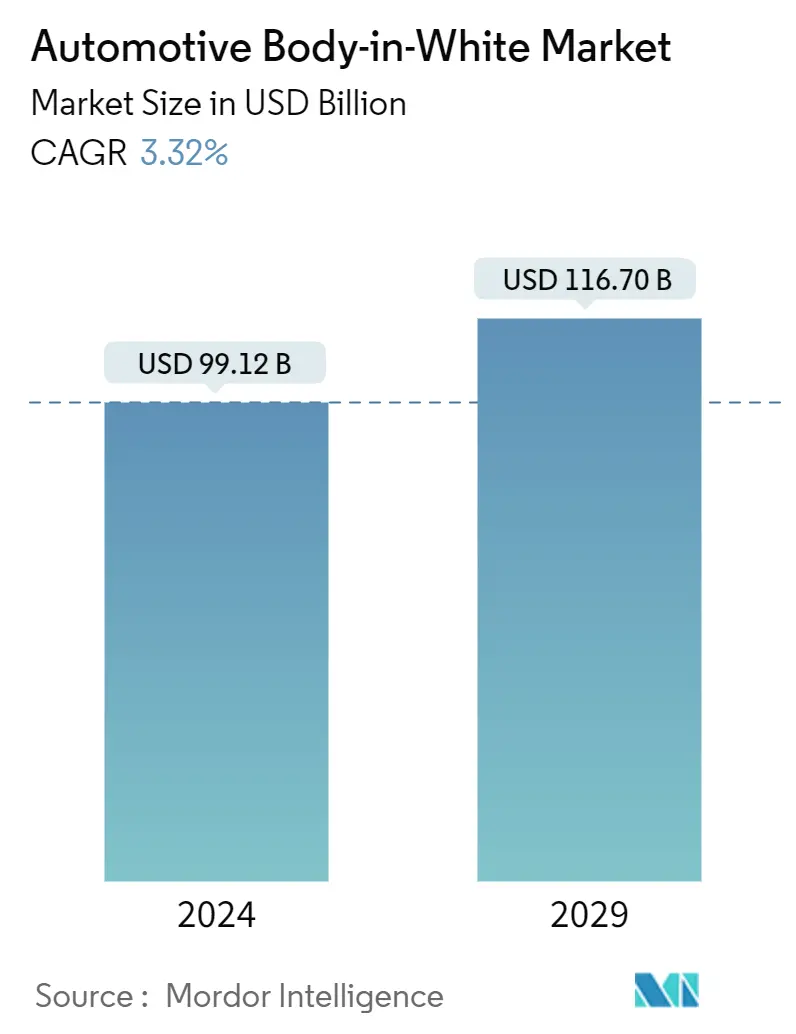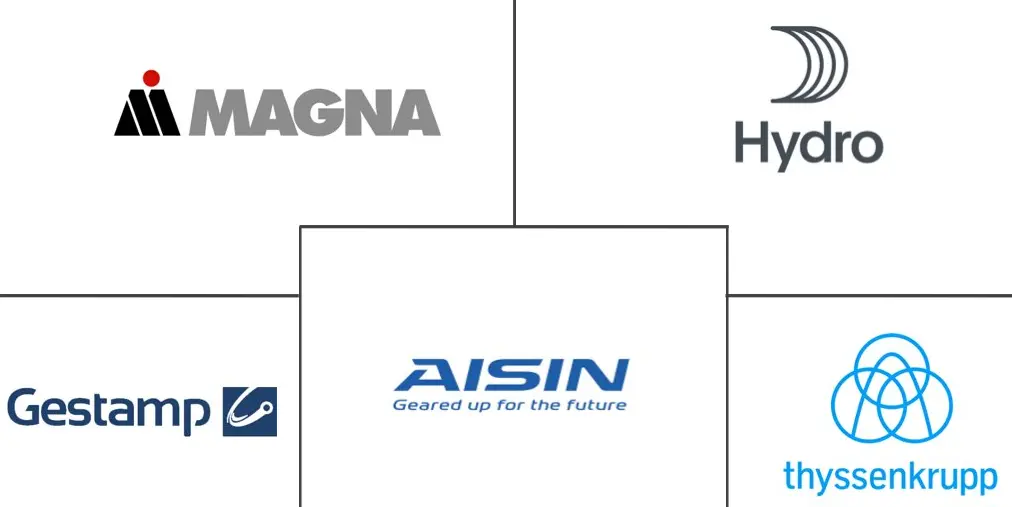Market Size of Automotive Body-in-White Industry

| Study Period | 2019 - 2029 |
| Market Size (2024) | USD 99.12 Billion |
| Market Size (2029) | USD 116.70 Billion |
| CAGR (2024 - 2029) | 3.32 % |
| Fastest Growing Market | Asia-Pacific |
| Largest Market | Asia-Pacific |
| Market Concentration | Medium |
Major Players
*Disclaimer: Major Players sorted in no particular order |
Automotive Body-in-White Market Analysis
The Automotive Body-in-White Market size is estimated at USD 99.12 billion in 2024, and is expected to reach USD 116.70 billion by 2029, growing at a CAGR of 3.32% during the forecast period (2024-2029).
Over the long term, stringent environmental regulations and emission norms, along with the rising adoption of lightweight materials in vehicles to achieve fuel efficiency, are expected to propel the market demand during the forecast period.
The development of solid-state laser sources in the past decade has offered new welding solutions for BIW assembly. In particular, improved electrical efficiency (cost reductions) and the capability to combine optic fibers and long working distances (tool flexibility) offer new possibilities.
For instance, in April 2023, Comau revealed that it had provided a highly intelligent welding solution for Hycan Automotive Technology Co., Ltd.'s frame line. It guarantees multi-model production of new energy cars, high JPH (Jobs per Hour), and a tangible decrease in production losses. It is used at the Hycan Hangzhou production facility. It can transition between four distinct platforms at random, is completely compatible with existing production platforms, and is mass-producing pure electric A06 automobile and SUV Z03 at 60 JPH cycle efficiency. The solution is built on a modified version of Comau's Opengate frame technology, which allows for flexible high-precision body-in-white construction and virtual commissioning.
Moreover, ongoing R&D on new alloys and efficient manufacturing techniques and increasing investments in automation and robots in the production process are likely to offer new opportunities for players in the market. Apart from this, the body in white is an integral structure for all automobiles. Hence, the development of the automobile sector will also add to the growth of the global body-in-white market.
For instance, in June 2023, NDR Auto Component Limited emphasized the importance of metal components and cosmetic components (trim cover) in the seat. The company's R&D team is now working on numerous product portfolios in these areas. Its metal components team is working on the creation of passenger vehicle seat frames, passenger car body-in-white (B-I-W) parts, and two-wheeler components.
Additionally, the government initiatives adopted in countries like India and China, promoting manufacturing and contributing to the growth of this market.
Automotive Body-in-White Industry Segmentation
Automotive body-in-white refers to the phase in automotive manufacturing in which the sheet metal body components of an automobile have been welded together. In other words, the automotive body-in-white is the frame structure of the automobile before painting and assembly of the engine, chassis, glass, seat, doors, hood, and other such sub-assemblies.
The automotive body-in-white market is segmented by vehicle type (passenger vehicles and commercial vehicles), propulsion type (IC engine and electric vehicles), material type (aluminum, steel, composites, and other material types), material joining technique (welding, clinching, laser brazing, bonding, and other material joining techniques), and geography (North America, Europe, Asia-Pacific, and Rest of the World).
The report offers market size and forecast for the Automotive Body-in-White market in value (USD) for all the above segments.
| Vehicle Type | |
| Passenger Vehicles | |
| Commercial Vehicles |
| Propulsion Type | |
| IC Engines | |
| Electric Vehicles |
| Material Type | |
| Aluminum | |
| Steel | |
| Composites | |
| Other Material Types |
| Material Joining Technique | |
| Welding | |
| Clinching | |
| Laser Brazing | |
| Bonding | |
| Other Material Joining Techniques |
| Geography | |||||||
| |||||||
| |||||||
| |||||||
|
Automotive Body-in-White Market Size Summary
The automotive body-in-white market is poised for steady growth over the forecast period, driven by the increasing demand for fuel-efficient vehicles and the adoption of lightweight materials. This growth is further supported by advancements in manufacturing technologies, such as solid-state laser welding solutions, which offer improved efficiency and flexibility in BIW assembly. The market is also benefiting from ongoing research and development in new alloys and manufacturing techniques, as well as increased investments in automation and robotics. These developments are crucial as the body-in-white structure is integral to all automobiles, and the overall growth of the automotive sector is expected to bolster market expansion. Additionally, government initiatives in regions like Asia-Pacific, particularly in countries such as India and China, are promoting manufacturing and electric vehicle adoption, further contributing to market growth.
Key players in the automotive body-in-white market, including Magna International Inc., Norsk Hydro ASA, and Thyssenkrupp AG, are actively expanding their product offerings and engaging in strategic collaborations to strengthen their market positions. The market is characterized by a moderate level of consolidation, with both regional and global giants competing for market share. Innovations in lightweight materials, such as composites and fiber-reinforced plastics, are enabling the production of lighter vehicles, aligning with customer-driven requirements for improved styling, comfort, and reduced noise and vibration. The focus on sustainability and compliance with stringent emission and safety regulations is driving manufacturers to adopt innovative technologies and processes, ensuring the market remains competitive and poised for growth during the forecast period.
Automotive Body-in-White Market Size - Table of Contents
-
1. MARKET DYNAMICS
-
1.1 Market Drivers
-
1.1.1 Growing Demand for Lightweight Vehicles to Drive the Automotive Body-in-White Market
-
-
1.2 Market Restraints
-
1.2.1 High Cost of Materials to Manufacture BIW Structures is Expected to Limit Market Growth.
-
-
1.3 Industry Attractiveness - Porter's Five Forces Analysis
-
1.3.1 Bargaining Power of Suppliers
-
1.3.2 Bargaining Power of Consumers
-
1.3.3 Threat of New Entrants
-
1.3.4 Threat of Substitute Products
-
1.3.5 Intensity of Competitive Rivalry
-
-
-
2. MARKET SEGMENTATION (Market Value in USD)
-
2.1 Vehicle Type
-
2.1.1 Passenger Vehicles
-
2.1.2 Commercial Vehicles
-
-
2.2 Propulsion Type
-
2.2.1 IC Engines
-
2.2.2 Electric Vehicles
-
-
2.3 Material Type
-
2.3.1 Aluminum
-
2.3.2 Steel
-
2.3.3 Composites
-
2.3.4 Other Material Types
-
-
2.4 Material Joining Technique
-
2.4.1 Welding
-
2.4.2 Clinching
-
2.4.3 Laser Brazing
-
2.4.4 Bonding
-
2.4.5 Other Material Joining Techniques
-
-
2.5 Geography
-
2.5.1 North America
-
2.5.1.1 United States
-
2.5.1.2 Canada
-
2.5.1.3 Rest of North America
-
-
2.5.2 Europe
-
2.5.2.1 Germany
-
2.5.2.2 United Kingdom
-
2.5.2.3 France
-
2.5.2.4 Spain
-
2.5.2.5 Rest of Europe
-
-
2.5.3 Asia-Pacific
-
2.5.3.1 India
-
2.5.3.2 China
-
2.5.3.3 Japan
-
2.5.3.4 South Korea
-
2.5.3.5 Rest of Asia-Pacific
-
-
2.5.4 Rest of the World
-
2.5.4.1 South America
-
2.5.4.2 Middle-East and Africa
-
-
-
Automotive Body-in-White Market Size FAQs
How big is the Automotive Body-in-White Market?
The Automotive Body-in-White Market size is expected to reach USD 99.12 billion in 2024 and grow at a CAGR of 3.32% to reach USD 116.70 billion by 2029.
What is the current Automotive Body-in-White Market size?
In 2024, the Automotive Body-in-White Market size is expected to reach USD 99.12 billion.

